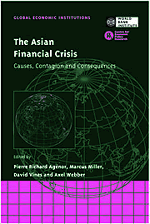Introduction
Published online by Cambridge University Press: 26 February 2010
Summary
In countries hit by the Asian financial crisis there stalked dark shadows whose like had not been seen since the Great Depression: one after another, banks and currencies collapsed and confident growth ceded to fierce contraction. The waiting world watched in shocked surprise, and wondered: Why did the crisis happen? Why did it spread like wildfire from country to country in the second half of 1997? Why were its effects so serious? What can be done to aid recovery?
These are important questions, both for the world's citizens and for economic analysis. This volume brings together studies by a number of distinguished scholars and policy-makers who try to answer them. The authors seek to clarify:
(1) the role of ‘vulnerability’ in what happened
(2) the interconnection between currency crisis and financial crisis, and how they combined to cause collapse
(3) what the mechanisms of contagion were
(4) what needs to be done, subsequent to this collapse.
The book is divided into four parts.
Part One begins with four wide-ranging chapters that, taken together, provide a systematic overview. In chapter 1 Alba, Bhattacharya, Claessens, Ghosh and Hernandez mobilise the research resources of the World Bank to provide a detailed empirical account of the crisis. In interpreting what happened, they make two major points. First, they show how events in East Asia have thrown up challenges for macroeconomic management in a financially integrated world. Second, they demonstrate the importance of avoiding risky financial structures.
- Type
- Chapter
- Information
- The Asian Financial CrisisCauses, Contagion and Consequences, pp. 1 - 6Publisher: Cambridge University PressPrint publication year: 1999

